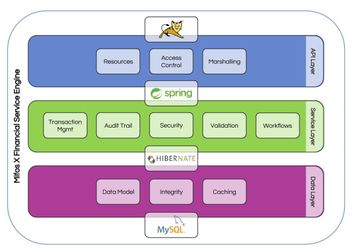The main components of this layer are:
- Resources
- Every module is exposed via an URI (Unique Resource Identifier).
- Access Control
- Early exit if a consumer lacks authorization for a queried Resource.
- Data marshalling
- Any data transmitted to and from the API is de-/serialized using JSON.
The API is exposed via HTTPS to encrypt all data and secure the communication. OAuth2 is used for authorization.
Stateless by nature the API Layer can be scaled based on the actual load and even used in high availability scenarios.
Service Layer
The Service Layer provides module specific business logic and rules, role based access control and a xBRL compliant reporting engine. Transaction awareness and data validity is encapsulated, and extension points (i.e. A basic rule for building modular software systems) are available to enhance built-in workflows.
Cross concerns like Security or Transactions are part of the core framework and provided via AOP (Aspect Oriented Programming).
The Service Layer has horizontal and vertical layers.
Services, command, and event handlers form horizontal layers; functional modules form vertical layers.
Data Layer
The Data Layer provides module specific access to data stores. Data integrity is reached by using the ACID principal and well defined data relations. Write and read operations are encapsulated in different repositories to define a clean responsibility separation.
The Data Layer uses two cache strategies to cache data efficiently; database and 2nd level caching.
- Database caching stores records on the database level and is useful for reporting, batch jobs, and low level SQL queries.
- 2nd Level caching stores data objects on the application level and keeps database turnarounds on a very low level allowing fast in-memory access of frequent data.
Architecture
The Engine’s architecture was designed with a focus on modern, scalable and extensible technologies ready to run in the cloud. All components where selected based on their maturity, proven reliability and cost efficiency.
It is our goal to provide a software that is deployable with effectively no cost that can grow with the customer need over time using well known best practices and support from a wide range of communities.
The basic Mifos X Financial Service Engine architecture is as follows:
| Resource | Component | Comment | |
|---|---|---|---|
| Operating System | Linux , Windows, Mac OS | Amazon AWS image and Debian package available | |
| Runtime | Java 7.x | ||
| Application Server | Tomcat 7.x | Embedded Tomcat for development environments | |
| Database | MySQL 5.x | Embedded MariaDB for development environments | |
| Application Framework | Spring Framework 4.x | ||
| Persistence Framework | Hibernate 4.x | ||
| Reporting Engine | Pentaho Reporting Engine 3.x | ||
| Test Framework | JUnit 4.x Mockito 1.x REST-assured 2.x |
Mifos X Community App
Mifos X Community App (simply “the Community App”) is a browser based Single Page Application (SPA) built entirely with HTML, JavaScript and CSS. Resources are loaded dynamically and added to the page as necessary.
All user interactions, workflows, and application logic is taking place in the browser and does not create load on the Engine. Ajax is used to send data to and receive data from the Engine asynchronous, and bidirectional model binding update views automatically.
Based on AngularJS the Community App is built on the MVC (Model-View-Controller) pattern and uses templates to render dynamic content. To provide a responsive and modern look and feel Bootstrap is part of the application stack.
The basic Mifos X Community App components are as follows:
| Resource | Component |
|---|---|
| Application Framework | AngularJS 1.x |
| Dependency Management | Bower 1.x |
| Module Management | RequireJS 2.x |
| Chart Library | D3 3.x |
| Look and Feel | Bootstrap 3.x |
| Test Framework | Jasmine 1.x |
